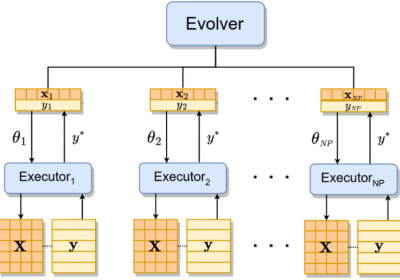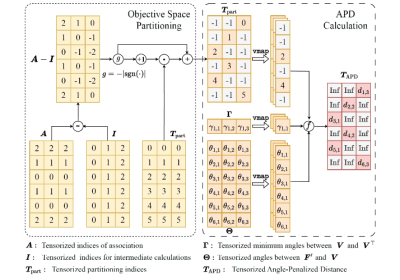Cheng He, Shihua Huang, Ran Cheng*, Kay Chen Tan, Yaochu Jin

Abstract:
Recently, increasing works have been proposed to drive evolutionary algorithms using machine-learning models. Usually, the performance of such model-based evolutionary algorithms is highly dependent on the training qualities of the adopted models. Since it usually requires a certain amount of data (i.e., the candidate solutions generated by the algorithms) for model training, the performance deteriorates rapidly with the increase of the problem scales due to the curse of dimensionality. To address this issue, we propose a multiobjective evolutionary algorithm driven by the generative adversarial networks (GANs). At each generation of the proposed algorithm, the parent solutions are first classified into real and fake samples to train the GANs; then the offspring solutions are sampled by trained GANs. Thanks to the powerful generative ability of the GANs, our proposed algorithm is capable of generating promising offspring solutions in high-dimensional decision space with limited training data. The proposed algorithm is tested on ten benchmark problems with up to 200 decision variables. The experimental results on these test problems demonstrate the effectiveness of the proposed algorithm. [Source Code]
Results
Effectiveness of the Model Training Method

Figure 1: The offsprings generated by the original GANs and our modified GANs at different iterations of the evolution on IMF1 with 200 decision variables.

Figure 2: The offsprings generated by the original GANs and our modified GANs at different iterations of the evolution on IMF4 with 200 decision variables.

Figure 3: The trajectories of generator and discriminator’s training losses of the original GAN (with multivariate Gaussian model disabled) and our modified GAN during the evolution, respectively.
Performance on IMF Problems

Table 1: IGD results obtained by NSGA-II, MOEA/D-DE, MOEA/D-CMA, IM-MOEA, GDE3, SPEA2, and GMOEA on 40 IMF test instances. The best result in each row is highlighted.

Figure 4: The final non-dominated solutions obtained by the compared algorithms on bi-objective IMF3 with 200 decision variables in the run associated with the median IGD value.

Figure 5: The final non-dominated solutions obtained by the compared algorithms on bi-objective IMF8 with 200 decision variables in the run associated with the median IGD value.

Figure 6: The convergence profiles of the seven compared algorithms on IMF3, IMF5, and IMF7 with 200 decision variables, respectively.
Effectiveness of Hybrid Offspring Generation

Figure 7: The comparisons between GMOEA_O (GMOEA without hybrid reproduction) and GMOEA on ten IMF problems with different number of decision variables.

Figure 8: The statistics of IGD results achieved by GMOEA* (the reproduction with pure genetic operators), GMOEA- (the reproduction with pure GAN operator), and GMOEA (the reproduction with the hybrid strategy) on seven IMF problems with a number of 30, 50, 100, and 200 decision variables, respectively.
Citation
@article{he2020evolutionary,
title={Evolutionary multiobjective optimization driven by generative adversarial networks (GANs)},
author={He, Cheng and Huang, Shihua and Cheng, Ran and Tan, Kay Chen and Jin, Yaochu},
journal={IEEE transactions on cybernetics},
volume={51},
number={6},
pages={3129--3142},
year={2020},
publisher={IEEE}
}Acknowledgments:
This work was supported in part by the National Natural Science Foundation of China under Grant 61903178 and Grant 61906081, in part by the Program for Guangdong Introducing Innovative and Entrepreneurial Teams under Grant 2017ZT07X386, in part by the Shenzhen Peacock Plan under Grant KQTD2016112514355531, in part by the Program for University Key Laboratory of Guangdong Province under Grant 2017KSYS008, and in part by the Research Grants Council of the Hong Kong under Grant CityU11202418 and Grant CityU11209219.

![[IEEE TCYB] Evolutionary Multiobjective Optimization Driven by Generative Adversarial Networks (GANs)](https://www.emigroup.tech/wp-content/uploads/2021/07/图片11-1-840x420.png)


